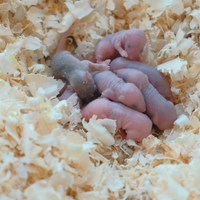Login
Subscribeepigenetics, genetics & genomics, genetics

Our Favorite Genetics Stories of 2021
Christie Wilcox, PhD | Dec 23, 2021 | 4 min read
Studies The Scientist covered this year illustrate the expanding importance of genetic and genomic research in all aspects of life science, from ecology to medicine.

How Hydras Regenerate Decapitated Heads
Dan Robitzski | Dec 14, 2021 | 5 min read
Hydra vulgaris constantly replenish the cells in their heads and grow new ones to reproduce asexually. But gene expression analyses reveal that regenerating a head after an injury is a very different process.

Advances in Nucleic Acid Sequencing
The Scientist | 1 min read
Download this eBook to learn how new sequencing methods revolutionize genetics research!

Infographic: A Yeast Model for Studying Histone Modifications
Amanda Heidt | Sep 1, 2021 | 1 min read
The methodology involves modifying histones and displaying them on the cell surface for analysis.

Yeast “Mini Labs” Help Researchers Probe Histone Modifications
Amanda Heidt | Sep 1, 2021 | 3 min read
By harnessing a unique property of yeast, scientists can synthesize histones and the enzymes that modify these proteins, which spool DNA and influence gene expression.

Exercising During Pregnancy Protects Mouse Offspring
Jack J. Lee | Aug 1, 2021 | 2 min read
Obese mice that exercised while pregnant gave birth to pups that grew up free of the metabolic issues present in the adult young of sedentary obese mothers—possibly by staving off epigenetic changes to a key metabolic gene.

Q&A: How Animals Change in Space
Jef Akst | Nov 25, 2020 | 4 min read
Weill Cornell Medicine geneticist Christopher Mason speaks with The Scientist about a bolus of new work on the physiological, cellular, and molecular effects of leaving Earth.

Inheriting Memories
The Scientist | Jan 13, 2020 | 1 min read
Tel Aviv University neuroscientist Oded Rechavi discusses his studies on the inheritance of acquired traits.

Oded Rechavi Studies the RNA Nematodes Pass to Their Offspring
Emily Makowski | Jan 13, 2020 | 3 min read
The Tel Aviv University researcher is interested in how the macromolecules affect the health and behavior of successive generations of worms.

Researchers Analyze Epigenetic Signatures to Diagnose Rare Diseases
Katarina Zimmer | Mar 28, 2019 | 5 min read
A number of rare diseases show unique epigenetic patterns across the genome, a feature researchers have now exploited to build a diagnostic tool.

Lack of Diversity in Genetic Datasets is Risky for Treating Disease
Ashley Yeager | Mar 21, 2019 | 6 min read
Certain populations have been historically underrepresented in genome sequencing studies, but the NIH, private clinics, and 23andMe and other companies are trying to fix that.

Researchers Engineer Epigenome Editors to Study How Gene Expression Affects Disease
Ashley Yeager | Jan 1, 2019 | 7 min read
Using CRISPR and other tools, scientists are modifying DNA methylation, histone marks, and other modifiers of gene expression to understand how they affect health and disease.

Nicotine’s Effects Passed On Through Generations of Mice
Kerry Grens | Oct 16, 2018 | 2 min read
Male rodents exposed to nicotine had changes in sperm genome methylation and produced pups and grandpups with abnormal behavior.

In Their Earliest Days, Embryos Record Their Environments
Kerry Grens | Oct 1, 2018 | 4 min read
Methylation patterns at so-called metastable epialleles in the genome stamp a memory into each of our cells.

Study Finds Epigenetic Differences Between Hatchery-Raised and Wild-Born Salmon
Shawna Williams | Mar 1, 2018 | 4 min read
The variation may help explain why stocked salmon don’t fare as well in the ocean.

Infographic: How Embryos Take Control of Their Own Development
Jef Akst | Nov 30, 2017 | 3 min read
The switch from maternal factors involves dynamic reprogramming of the zygotic genome.

Infographic: The Various Forms of Methylated DNA
Skirmantas Kriaucionis | Aug 31, 2017 | 1 min read
To expand the basic nucleotide alphabet, many species modify their DNA with epigenetic marks.

Epigenetic Inheritance in Nematodes
Catherine Offord | Jul 16, 2017 | 2 min read
The memory of a temperature spike can persist for as many as 14 generations in C. elegans.

RNA Protects “Naked” Genomes from Retrotransposons
Shawna Williams | Jun 30, 2017 | 1 min read
Transfer RNA fragments prevent jumping genes from hopping around in the mouse embryo, when histone methylation can’t do the job.
